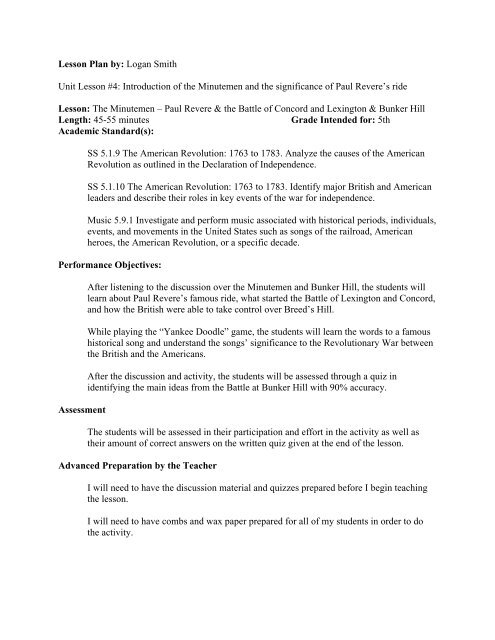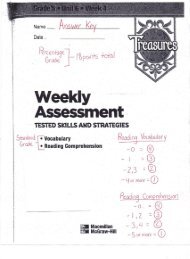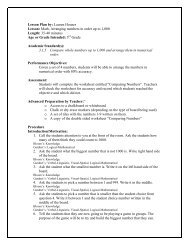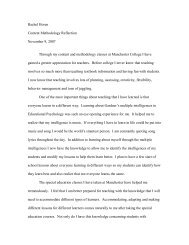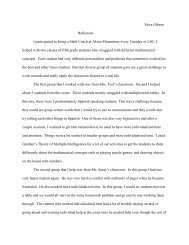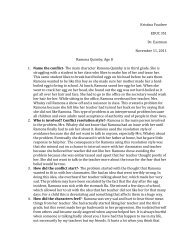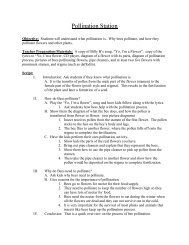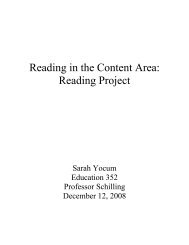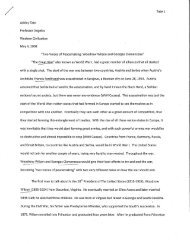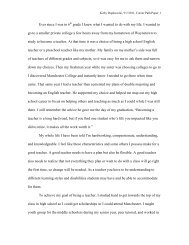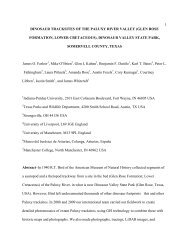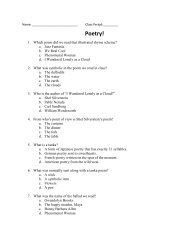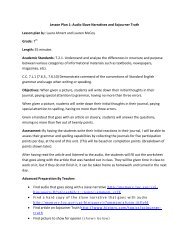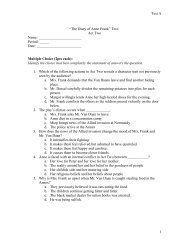Lesson Plan by: Logan Smith Unit Lesson #4: Introduction of the ...
Lesson Plan by: Logan Smith Unit Lesson #4: Introduction of the ...
Lesson Plan by: Logan Smith Unit Lesson #4: Introduction of the ...
You also want an ePaper? Increase the reach of your titles
YUMPU automatically turns print PDFs into web optimized ePapers that Google loves.
<strong>Lesson</strong> <strong>Plan</strong> <strong>by</strong>: <strong>Logan</strong> <strong>Smith</strong><br />
<strong>Unit</strong> <strong>Lesson</strong> <strong>#4</strong>: <strong>Introduction</strong> <strong>of</strong> <strong>the</strong> Minutemen and <strong>the</strong> significance <strong>of</strong> Paul Revere’s ride<br />
<strong>Lesson</strong>: The Minutemen – Paul Revere & <strong>the</strong> Battle <strong>of</strong> Concord and Lexington & Bunker Hill<br />
Length: 45-55 minutes Grade Intended for: 5th<br />
Academic Standard(s):<br />
SS 5.1.9 The American Revolution: 1763 to 1783. Analyze <strong>the</strong> causes <strong>of</strong> <strong>the</strong> American<br />
Revolution as outlined in <strong>the</strong> Declaration <strong>of</strong> Independence.<br />
SS 5.1.10 The American Revolution: 1763 to 1783. Identify major British and American<br />
leaders and describe <strong>the</strong>ir roles in key events <strong>of</strong> <strong>the</strong> war for independence.<br />
Music 5.9.1 Investigate and perform music associated with historical periods, individuals,<br />
events, and movements in <strong>the</strong> <strong>Unit</strong>ed States such as songs <strong>of</strong> <strong>the</strong> railroad, American<br />
heroes, <strong>the</strong> American Revolution, or a specific decade.<br />
Performance Objectives:<br />
Assessment<br />
After listening to <strong>the</strong> discussion over <strong>the</strong> Minutemen and Bunker Hill, <strong>the</strong> students will<br />
learn about Paul Revere’s famous ride, what started <strong>the</strong> Battle <strong>of</strong> Lexington and Concord,<br />
and how <strong>the</strong> British were able to take control over Breed’s Hill.<br />
While playing <strong>the</strong> “Yankee Doodle” game, <strong>the</strong> students will learn <strong>the</strong> words to a famous<br />
historical song and understand <strong>the</strong> songs’ significance to <strong>the</strong> Revolutionary War between<br />
<strong>the</strong> British and <strong>the</strong> Americans.<br />
After <strong>the</strong> discussion and activity, <strong>the</strong> students will be assessed through a quiz in<br />
identifying <strong>the</strong> main ideas from <strong>the</strong> Battle at Bunker Hill with 90% accuracy.<br />
The students will be assessed in <strong>the</strong>ir participation and effort in <strong>the</strong> activity as well as<br />
<strong>the</strong>ir amount <strong>of</strong> correct answers on <strong>the</strong> written quiz given at <strong>the</strong> end <strong>of</strong> <strong>the</strong> lesson.<br />
Advanced Preparation <strong>by</strong> <strong>the</strong> Teacher<br />
I will need to have <strong>the</strong> discussion material and quizzes prepared before I begin teaching<br />
<strong>the</strong> lesson.<br />
I will need to have combs and wax paper prepared for all <strong>of</strong> my students in order to do<br />
<strong>the</strong> activity.
I will need to have all <strong>of</strong> <strong>the</strong> words to <strong>the</strong> song, “Yankee Doodle” written on cards as well<br />
as have a pocket chart prepared for <strong>the</strong> students to put <strong>the</strong> cards into for <strong>the</strong> purpose <strong>of</strong><br />
<strong>the</strong> activity.<br />
Lastly I need to make sure that I have a recording <strong>of</strong> <strong>the</strong> song, “Yankee Doodle”, in<br />
which I can play for <strong>the</strong> students over and over again during <strong>the</strong> activity.
Bloom’s Questions<br />
• Who were <strong>the</strong> Minutemen and why were <strong>the</strong>y called that? (Knowledge)<br />
• What was <strong>the</strong> significance <strong>of</strong> <strong>the</strong> first shot at <strong>the</strong> Battle <strong>of</strong> Lexington and Concord?<br />
(Comprehension)<br />
• Was it a smart decision <strong>by</strong> Paul Revere to ride through <strong>the</strong> battle grounds? Why or why<br />
not? (Analysis)<br />
• What was <strong>the</strong> actual name <strong>of</strong> <strong>the</strong> Hill <strong>the</strong>y were fighting on? (Knowledge)<br />
• Who was in control <strong>of</strong> this battle, <strong>the</strong> British or <strong>the</strong> Americans? (Evaluation)<br />
• What would happen to <strong>the</strong> British soldiers if on <strong>the</strong> third charge up <strong>the</strong> hill, <strong>the</strong> colonists<br />
didn’t run out <strong>of</strong> ammunition? (Syn<strong>the</strong>sis)<br />
• Can you relate this type <strong>of</strong> back and forth battle to anything you’ve ever experienced in<br />
your own life? (Application)<br />
Procedure<br />
<strong>Introduction</strong> / Motivation<br />
To introduce this lesson I will need to review some <strong>of</strong> <strong>the</strong> material discussed from <strong>the</strong><br />
previous lesson involving <strong>the</strong> Boston Massacre and Boston Tea Party. I will review with<br />
<strong>the</strong>m how <strong>the</strong> Boston Massacre began through a simple snowball fight and how this fight<br />
sparked an even greater battle which eventually led to <strong>the</strong> onset <strong>of</strong> <strong>the</strong> Boston Tea Party.<br />
We will discuss <strong>the</strong> hatred between <strong>the</strong> British soldiers and Americans, <strong>the</strong> involvement<br />
<strong>of</strong> <strong>the</strong> British East India Company, <strong>the</strong> significance <strong>of</strong> tea, <strong>the</strong> wannabe Mohawk Indians,<br />
and <strong>the</strong> influence <strong>of</strong> Paul Revere. I will be looking for several responses from my<br />
students to show that <strong>the</strong>y remembered <strong>the</strong> previous material, but also so that <strong>the</strong>y are<br />
able to relate that lesson to a small fraction <strong>of</strong> <strong>the</strong> Revolutionary War.<br />
I will introduce <strong>the</strong> importance <strong>of</strong> <strong>the</strong> Minutemen to <strong>the</strong> Battle <strong>of</strong> Lexington and<br />
Concord.<br />
In New England men began arming <strong>the</strong>mselves. These men were known as minutemen<br />
because <strong>the</strong>y could be ready to fight in a matter <strong>of</strong> a minute.<br />
They practiced fighting and marching with wooden guns.<br />
On April 18, 1775 <strong>the</strong> British commander in Boston sent soldiers to Concord to find guns<br />
and powder.
They were also ordered to arrest Samuel Adams and John Hancock who were hiding in<br />
Lexington.<br />
Paul Revere made his famous midnight ride from Boston to Lexington, Massachusetts to<br />
warn <strong>the</strong> citizens that <strong>the</strong> British army was on its way.<br />
The next day <strong>the</strong> battle <strong>of</strong> Lexington and Concord took place. The first shot fired was<br />
later known as "The shot heard 'round <strong>the</strong> World" due to <strong>the</strong> impact <strong>of</strong> <strong>the</strong> war that<br />
followed.<br />
Next we will briefly discuss <strong>the</strong> Battle that occurred at Bunker Hill<br />
The colonists took a hill that overlooked <strong>the</strong> Boston Harbor. The hill was called Breed's<br />
Hill after its owner. The army thought <strong>the</strong>y were on a different hill named
Bunker Hill which was near<strong>by</strong>. The battle that took placed was called <strong>the</strong> Battle <strong>of</strong><br />
Bunker Hill because <strong>of</strong> this mistake.<br />
The battle began when <strong>the</strong> British commander sent soldiers up <strong>the</strong> hill to take it from <strong>the</strong><br />
colonists. The British were forced back <strong>by</strong> <strong>the</strong> Americans muskets. They charged again<br />
and were again driven back <strong>by</strong> colonial guns.<br />
On <strong>the</strong> third charge <strong>the</strong> colonists were almost out <strong>of</strong> ammunition so <strong>the</strong> British were able<br />
to take over Breed's Hill. The colonial army lost 140 men in <strong>the</strong> battle. The British army<br />
lost many more. Nearly 1000 British were killed or wounded.<br />
The song Yankee Doodle was written <strong>by</strong> <strong>the</strong> British to make fun <strong>of</strong> <strong>the</strong> Americans. The<br />
Americans however adopted <strong>the</strong> song and began singing as <strong>the</strong>ir own. The song was<br />
heard throughout <strong>the</strong> Revolutionary War from <strong>the</strong> time <strong>the</strong> British retreated at Concord to<br />
<strong>the</strong> Americans' surrender at Yorktown.<br />
Using combs and wax paper, we will make a game with <strong>the</strong> words <strong>of</strong> “Yankee Doodle”.<br />
Divide <strong>the</strong> class into two teams (Gardner’s Interpersonal). Team one lines up. The<br />
words are written on cards <strong>the</strong>n thrown randomly on <strong>the</strong> floor. The first player for team<br />
one walks to find <strong>the</strong> first word <strong>of</strong> <strong>the</strong> song and places it in a pocket chart that will be<br />
made <strong>by</strong> me before <strong>the</strong> lesson (Gardner’s Bodily Kines<strong>the</strong>tic).<br />
That player <strong>the</strong>n walks to <strong>the</strong> end <strong>of</strong> <strong>the</strong> line while <strong>the</strong> second player for team one finds<br />
<strong>the</strong> second word to <strong>the</strong> song, places it in <strong>the</strong> chart, <strong>the</strong>n walks to <strong>the</strong> end <strong>of</strong> <strong>the</strong> line<br />
(Gardner’s Bodily Kines<strong>the</strong>tic).<br />
Play continues in this manner until all <strong>the</strong> words are in <strong>the</strong> correct order on <strong>the</strong> pocket<br />
chart (Gardner’s Linguistic Intelligence). I will time <strong>the</strong> students as <strong>the</strong>y play and once<br />
<strong>the</strong> first team has finished <strong>the</strong> song <strong>the</strong> second team will go and try to beat <strong>the</strong> first team’s<br />
time.<br />
The time will be recorded <strong>by</strong> playing <strong>the</strong> song “Yankee Doodle” and <strong>the</strong> winner will be<br />
determined <strong>by</strong>:<br />
How many times did team one listen to <strong>the</strong> song as <strong>the</strong>y raced to put <strong>the</strong> words in order?<br />
How many times did team two listen to <strong>the</strong> song?<br />
Whichever team listened to “Yankee Doodle” for <strong>the</strong> shortest amount <strong>of</strong> time while also<br />
putting all <strong>of</strong> <strong>the</strong> words toge<strong>the</strong>r correctly in <strong>the</strong> pocket chart will be declared <strong>the</strong> winner<br />
<strong>of</strong> <strong>the</strong> game.<br />
We will <strong>the</strong>n form a line as a class and march around <strong>the</strong> room listening to and singing<br />
“Yankee Doodle” one time through (Gardner’s Musical Intelligence). This will give <strong>the</strong>
students an understanding <strong>of</strong> what <strong>the</strong> soldiers on both sides looked like during <strong>the</strong> war at<br />
Bunker Hill. The song, “Yankee Doodle”, was a very important song heard everywhere<br />
during this battle so it will provide knowledge and a connection for <strong>the</strong> students in<br />
relating <strong>the</strong> activity to what actually happened at Bunker Hill.
Closure<br />
The students will take a written quiz over some <strong>of</strong> <strong>the</strong> key concepts from <strong>the</strong> Battle at<br />
Bunker Hill and will be assessed <strong>by</strong> <strong>the</strong>ir amount <strong>of</strong> correct answers. (Gardner’s<br />
Intrapersonal)<br />
Tomorrow we will be talking about <strong>the</strong> forming <strong>of</strong> The Second Continental Congress and<br />
its’ leaders as well as <strong>the</strong> impact <strong>of</strong> <strong>the</strong> German soldiers (Hessians) during this ongoing<br />
battle between American & British soldiers.<br />
Adaptations / Enrichments<br />
For students with a learning disability or ADHD, <strong>the</strong> following adaptations might be<br />
considered:<br />
Provide <strong>the</strong>m with some facts over The Battle at Bunker Hill and <strong>the</strong> Minutemen to help<br />
guide <strong>the</strong>m through <strong>the</strong> lecture so <strong>the</strong>y are not confused.<br />
When playing <strong>the</strong> “Yankee Doodle” game tell <strong>the</strong> student which card to pick up on <strong>the</strong><br />
floor so that <strong>the</strong>y don’t hurt <strong>the</strong>ir team or strongly affect <strong>the</strong> outcome <strong>of</strong> <strong>the</strong> game.<br />
For students who are gifted or excelled, <strong>the</strong> following enrichment activities might be<br />
considered.<br />
Provide a “challenge quiz” for those excelled learners to give <strong>the</strong>m more difficult<br />
questions over <strong>the</strong> content <strong>of</strong> <strong>the</strong> lesson.<br />
Self Reflection: Questions to ask myself:<br />
Are <strong>the</strong> students paying attention and following along during <strong>the</strong> lecture at <strong>the</strong> beginning<br />
<strong>of</strong> <strong>the</strong> lesson?<br />
Do <strong>the</strong>y understand <strong>the</strong> material as we go through it in class?<br />
Am I thoroughly explaining <strong>the</strong> key terms and concepts?<br />
Is everyone participating in <strong>the</strong> “Yankee Doodle” game?<br />
Are <strong>the</strong> students making connections to <strong>the</strong>ir own lives during <strong>the</strong> game and through our<br />
class march at <strong>the</strong> end <strong>of</strong> <strong>the</strong> lesson?<br />
Are <strong>the</strong>y motivated to learn <strong>the</strong> material and is this teaching method enjoyable to learn?<br />
Works Cited<br />
http://www.mce.k12tn.net/revolutionary_war/american_revolution.htm


